
This parent guide supports parents in helping their child at home with the 8th grade Science content.
- Subject:
- Science
- Material Type:
- Reference Material
- Vocabulary
- Author:
- Kelly Rawlston
- Letoria Lewis
- Date Added:
- 10/11/2022

This parent guide supports parents in helping their child at home with the 8th grade Science content.

This resource accompanies our Rethink 8th Grade Science course. It includes ideas for use, ways to support exceptional children, ways to extend learning, digital resources and tools, tips for supporting English Language Learners and students with visual and hearing impairments. There are also ideas for offline learning.

In this activity, students play a game that simulates the carbon cycle. During the activity students will compare the carbon cycle before and after the industrial revolution.

Students learn about methane hydrate ice worms and hydrate shrimp, including how they obtain their food and interact with other species in deep sea ecosystems. Students will work in collaborative groups to research these organisms to develop hypotheses about the relationship between methane hydrates, ice worms, and hydrate shrimp and present their hypotheses to the class. In an extension activity, students will construct models of methane hydrate molecules.

Students will construct aquatic habitats in plastic bottles. They will observe the habitats for a period of four weeks and record what they see - changes in population, plant and animal growth, and water quality.
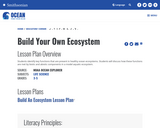
Students will create a model aquatic ecosystem and make regular observations over a period of time. They will also work collaboratively to conduct research on common ocean health issues and summarize their findings in a written report.

In this lesson, students create simple illustrations of how carbon flows between the biosphere, hydrosphere, atmosphere and lithosphere. Students will also use the provided materials to tell the story of how human activity can contribute to global climate change.

In this activity, students will learn that there is a finite amount of carbon on earth, which moves around in the environment, from one place to another.
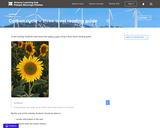
Students read about the carbon cycle using a three-level reading guide.

In this lesson, students will be introduced to climate change caused by greenhouse gases and participate in a simulation of the carbon cycle. Students will develop an understanding of how the movement of carbon atoms can contribute to climate change. Students will collect and analyze data on the movement of carbon atoms through the carbon cycle.
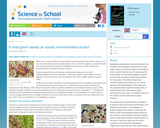
Students are introduced to the topic of bioremediation and collect information about Azolla, such as the morphology of water plants as opposed to land plants, the importance of symbiosis, the nitrogen cycle, the use of Azolla in agriculture, and Azolla’s ability to absorb heavy metals. Students formulate the research questions and hypotheses that they would like to investigate. Possible topics include measuring the gain in biomass depending on growth conditions (e.g. CO2 level, iron level in the water, amount of light), or the effect of Azolla on water quality.
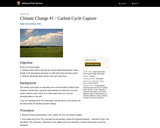
In this lesson, students describe the cyclical relationship between carbon dioxide in the atmosphere and plants on earth which trap and store carbon. Students will identify where carbon in the soil comes from.
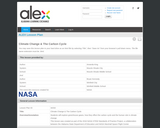
Students will explore greenhouse gases, how they affect the carbon cycle and the human role in climate change.
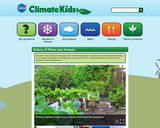
This series of 16 captioned images depict representative plant and animal species threatened by climate change. In contrast, images of healthy plants are also shown to emphasize their role in removing carbon dioxide from the atmosphere. The Climate Kids website is a NASA education resource featuring articles, videos, images and games focused on the science of climate change.

Students create a marine ecosystem and describe the adaptive, trophic, and symbiotic relationships between the biotic and abiotic components of the ecosystem.
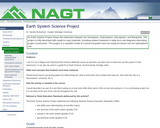
Students will construct an ecocolumn and use it to study the interaction between the geosphere, hydrosphere, atmosphere, and biosphere.
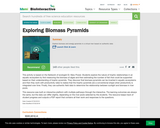
In this interactive activity, students explain a phenomenon, make hypotheses and predictions, and then test their predictions with data. Students will measure the biomass of primary producers in a defined area and extrapolate the amount of algal biomass in a river pool. Students will also investigate the relationship between biomass pyramids and pyramids of productivity and the role of the physical environment (mainly the amount of sunlight versus shade) on trophic biomass pyramids. This activity is based on the fieldwork of ecologist Dr. Mary Power.
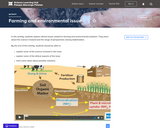
Students explore ethical issues related to farming and environmental pollution. They learn about the science involved and the range of perspectives among stakeholders.

Flowering plants keep the world cooler and wetter than it would be otherwise.

This activity introduces students to the ecosystem processes and interactions among populations, communities, and their environments. It will help students connect the flow of matter and energy through observations, lab work, and group field studies. Studying plant and animal life will directly focus on predator/prey, parasite/host, and producer/consumer/decomposer relationships.